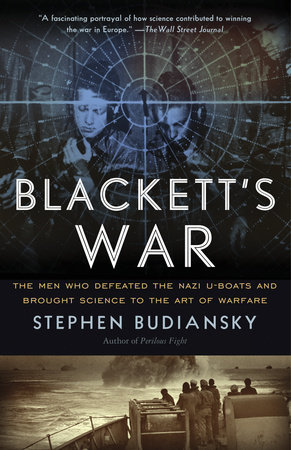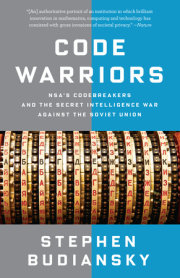Preface
From 1941 to 1943, a small group of British and American scientists, almost entirely without military experience or knowledge, revolutionized the way wars are run and won.
Applying the basic tools of their trade—a thoroughly scientific mind--set backed by little more than simple mathematics and probability theory—they repeatedly demonstrated to disbelieving admirals and generals ways to double or triple the effectiveness of the faltering Allied campaign against the German U--boats. In the grim fight for control of the Atlantic during those years of uncertainty, the scientists’ unconventional insights achieved the near--miraculous in a battle crucial to the larger struggle to defeat Hitler’s Germany.
The scientists who beat the U--boats never numbered more than a hundred in all, a fraction of the thousands who worked to achieve the two far better known triumphs of science in the war: the breaking of the German Enigma cipher and the making of the atomic bomb. Yet they were a collection of scientific talent the likes of which probably has never been seen before or since, certainly the oddest such collection ever assembled in one place: among them were physicists, chemists, botanists, physiologists, geneticists, insurance actuaries, economists, mathematicians, and astronomers. Six would win the Nobel Prize, in physics, chemistry, or medicine. Most were far to the left in their politics: some of the best were out-and-out Marxists, and more than a few had been committed pacifists who had come to see the defeat of the Nazis as a cause that overrode their abhorrence of war. Many were almost caricatures of the sort of unmilitary, awkward, overly intellectual civilians that military men routinely viewed with undisguised contempt.
That they were there when they were so desperately needed was the extraordinary result of a confluence of events and circumstances that I have set out to describe in the following pages: the onrush of devastating reality after decades of complacency toward the submarine menace, a political awakening of scientists brought about by the Great Depression and the rise of fascism, struggles within the militaries of Britain and the United States that pitted tradition against technical innovation and social change, and the appearance in the right place of a few unconventional political and military leaders who respected science—-and of a few phenomenally accomplished scientists of great moral courage and unshakable intellectual integrity.
Patrick Blackett, a British physicist, ex–naval officer, future Nobel winner, and ardent socialist, stood at the forefront of those scientists of penetrating insight and courage. It is no exaggeration to say that few men did more to win the war against Nazi Germany than Patrick Blackett. Certainly, few who did as much as he did have been so little remembered. Partly that is because he was a difficult, private, and inner--directed man whose political views and personality did not age well in the postwar world. Most people today—-myself included—-will find his uncritical admiration for Stalin’s Soviet Union and his doctrinaire social Marxism painfully naive, at best. But it is worth remembering that that same naïveté was the source of an idealism that we can only wish there was more of today: whatever else, Patrick Blackett was fired by a sense of justice, righteousness, and self--sacrificing courage that drove him to serve his country, and the cause of civilization itself, at the time of their utmost need.
As director of the antisubmarine analysis effort for the Royal Air Force and Royal Navy during World War II, Blackett not only helped win that battle, and the war, but in so doing founded the new science of operational research; it has been an indispensable part of military training and planning ever since, a revolution in the application of science to the art of warfare.
It is far from clear that he or any of his colleagues from those perilous and heroic days of the scientific war against the U--boats would have the chance to make such an original contribution today. The bureaucratic machinery of war has become too vast and cumbersome to leave room for the gifted improvisation and iconoclastic thinking that Blackett and his colleagues brought to bear; today’s routine incorporation of science in military affairs, which they themselves helped to bring about, has ironically sharpened the lines between military and civilian expertise; and science itself has become ever more narrow, specialized, and competitive, to the point that few scientists with the intensity to achieve discoveries worthy of a Nobel Prize have time left to think about much else.
Which is our loss, and which makes their story all the more worth telling.
Chapter 1
An Unconventional Weapon
On the evening of november 19, 1918, eight days after the armistice that ended the war to end all wars, a train from London pulled into the depot at Parkeston Quay, just outside the East Anglia port town of Harwich, and a mob of reporters, photographers, and newsreel cameramen spilled out onto the platform. Harwich had seen its ups and downs as a small North Sea port. In the Middle Ages the town prospered shipping bales of wool to the continent and importing French wines. In the seventeenth century, its dockyards served as an important supply and refitting base for the Royal Navy during the Dutch Wars; Samuel Pepys, the secretary to the Board of the Admiralty and keeper of the vain and ingenuous diaries that remain the most revealing account of life in Restoration England, represented the town in Parliament; and Harwich’s thriving private shipyards may, or may not, have built the merchant ship Mayflower, which carried the Pilgrim Fathers to America.
A slow decline in the nineteenth century—-the royal dockyards closed in 1829—-was abruptly reversed in the 1880s when the Great Eastern Railway Company developed a large new port on reclaimed land a mile up the River Stour from the town center. The railway was rerouted to a new station from which passengers could transfer directly to ferries that took them on to Gothenburg, Hamburg, and the Hook of Holland; there were freight yards, a hotel, and rows of terraced housing for workers. With the coming of war in 1914 the Royal Navy requisitioned the entire port—-quays, hotel, workshops, and all—-and a force of destroyers and light cruisers and the 8th and 9th Submarine Flotillas moved in to guard the northern approaches to the English Channel.
And so Harwich, with its men who knew submarines and its facilities for handling them and its proximity to Germany’s North Sea naval bases, was chosen as the place where an unprecedented event in the history of naval warfare was to take place on the morning of November 20, 1918. The terms of capitulation the German government had agreed to were extraordinary and humiliating, a measure of the desperation that the swift collapse of Germany’s military situation had left her leaders facing. Fourteen articles of the Armistice dealt with the German navy. In addition to disarming all her warships and agreeing to have 10 battleships, 6 battle cruisers, 8 light cruisers, and 50 destroyers “of the most modern type” interned in neutral or Allied ports, Germany was to surrender outright “all submarines at present in existence . . . with armament and equipment complete.” Article 22 continued:
"Those that cannot put to sea shall be deprived of armament and equipment and shall remain under the supervision of the Allies and the United States. Submarines ready to put to sea shall be prepared to leave German ports immediately on receipt of wireless order to sail to the port of surrender, the remainder to follow as early as possible. The conditions of this Article shall be completed within fourteen days of the signing of the Armistice."
Along with the horde of reporters, British submarine officers and men had been summoned from every port to be on hand to take charge of the enemy boats as they arrived. Accommodations at Parkeston, which included three moored depot ships, were packed far beyond capacity that evening of the 19th. The one “lady reporter” in the group was chivalrously offered the hotel billiard table as a bed for the night.
A heavy fog shrouded the harbor the next morning as the destroyers Melampus and Firedrake, carrying the boarding parties and their attendant pack of press hounds, got under way at 7 a.m. heading for the point where the surrender was to take place; it was the southern end of the shipping channel known as the Sledway, about eight miles east--northeast of Harwich. A British airship droned out of the mist and passed to the north, quickly vanishing again in the fog. Then a few minutes before 10 a.m. a British light cruiser suddenly came into sight in the distance, then two German transports flanked by more British warships.
And then there they were: a line of unmistakable, long thin hulls breaking the dark surface of the water, topped by domed conning towers, proceeding in straggling order. Two airships and three flying boats kept a continuous watch over the procession, passing and repassing low over the enemy boats as they came on slowly toward the rendezvous point. Lieutenant Stephen King--Hall, a British submarine torpedo officer, groped to find words to capture the incredulity he felt as he witnessed the scene from aboard the Firedrake: the dangerous and reclusive predator he and his comrades had hunted and feared and loathed, now meekly chivvied along like a few tame sheep. “Try and imagine what you would feel like,” he wrote, “if you were told to go to Piccadilly at 10 a.m. and see twenty man--eating tigers walk up from Hyde Park Corner and lie down in front of the Ritz to let you cut their tails off and put their leads on—-and it was really so.”
A signal was given to the transports to anchor, and one by one the line of twenty U--boats joined them under the guns of the British destroyers. Motor launches came alongside the Firedrake and the Melampus, and the British boarding crews, two or three officers and fifteen men for each U--boat, scrambled aboard. Not sure what to expect, the officers all carried sidearms. “We were prepared for any eventuality except that which actually took place,” recalled King--Hall. “We were not prepared to find the Huns behaving for once as gentlemen.”
King--Hall’s boarding of U--90 went by the book, with punctilious correctness. The German officers saluted; the salutes were duly returned; the German captain presented the signed terms of surrender—-all equipment intact and in working order, all ballast tanks blown, torpedoes on board but disarmed, no booby traps—-and the submarine’s officers seemed almost pathetically eager to be helpful, offering explanations of the operation of the boat and its gear. The same scene was being repeated all along the line. “My Hun,” remarked one of the British officers back in Harwich that evening, “might have been trying to sell me the boat, the blighter tried to be so obliging.”
As the submarines raised anchor the British crews ran up the white flag for the final transit into port. A strict order had been issued by the port commander that there would be no cheering or other demonstrations, and as the captured U--boats passed the ships in the harbor, crowded with spectators, they were greeted by silence. By 4 p.m. they were moored to buoys at the head of the harbor (at what “the reporters now say we call ‘U--boat Avenue,’ ” King--Hall sarcastically noted); a motor launch came alongside and the Germans, who had meanwhile changed into civilian garb that made them look more like peacetime caricatures of German tourists, green felt hat and all, than officers of a fierce and proud militarist state, were told to gather their belongings and get aboard. The launch took them to one of the British destroyers, which delivered them to the German transports for the trip back home, without ever having set foot on British soil.
Over the next eleven days the scene was repeated in daily succession as ninety--four more U--boats surrendered at Harwich, all without incident. Some of the German sailors inquired pathetically of the boarding crews if they thought they might be able to find work as merchant seamen in China or Japan, if Germans were now unwelcome anywhere closer to home. Two refused to return to Germany and insisted on staying in England, where they hoped to find “work and good food.” Many of the surrendering boats were commanded by junior and plainly nervous young officers, their regular captains apparently having refused to make the humiliating voyage; others flew the red flag of the revolutionaries who had seized parts of the German fleet in the waning days of the war, their captains elected by the crews and holding commissions signed by the Sailors’ and Soldiers’ Committee; in other boats the crews sullenly refused to obey orders of their regular officers except when it was clear that the order would be backed up by the British officer on board. Most, especially the older men who were members of the naval reserve and had been merchant sailors before the war, seemed simply relieved that it was over, and bade farewell to their boats with dry eyes and no apparent regrets.
In December 1918 the Allied Naval Commission discovered 62 additional seaworthy U--boats and another 149 still under construction at German bases and yards and ordered the immediate surrender of any that could sail or be towed and the destruction of the rest. The German government was warned that failure to turn over all of its U--boats intact would be answered by the Allies with the permanent occupation of its island naval base of Heligoland. The captured fleet, 176 boats in the end, was parceled out among the victors, most going to Britain and France, with token specimens awarded to the other Allies; Italy received 10, Japan 7, the United States 6, Belgium 2.
One of the behemoths of the German U--boat fleet—-the “super--submarine” Deutschland, originally constructed as a blockade-runner with a cargo capacity of 750 tons—-was scheduled to be broken up. But at the urging of members of Parliament it was instead towed to the Thames in October 1919 and exhibited to raise money for the King’s Fund for Sailors. “Poetic justice,” one member of Parliament declared with satisfaction.
But the real satisfaction to those who had battled this new undersea menace had come four months earlier, with the German signing of the Treaty of Versailles on June 28, 1919. Among its hundreds of detailed military stipulations, specifying everything from the maximum number of officers permitted in the headquarters of a cavalry division (15) to the number of rounds of ammunition that could be stocked per rifle or carbine (400), was Article 191, which declared: “The construction or acquisition of any submarine, even for commercial purposes, shall be forbidden in Germany.” In the course of the war Germany’s submarines had sunk over 5,000 Allied merchant vessels, totaling 12 million tons of shipping. No one before the war had imagined that the submarine, barely more than an inventor’s crackpot dream a few years earlier, would have been capable of bringing Great Britain, and its mightiest fleet on earth, to the edge of catastrophe in 1917; no one had imagined the inhumanity that the submarine would make routine and inevitable once it was unleashed in the only way it could be truly effective as a weapon of total war. But what man’s sordid ingenuity for destruction had created, the majesty of international law as decently dreamed of by Woodrow Wilson, and cynically seconded by his more worldly wise allies in London and Paris, would nobly or ignobly contain.
Copyright © 2013 by Stephen Budiansky. All rights reserved. No part of this excerpt may be reproduced or reprinted without permission in writing from the publisher.










